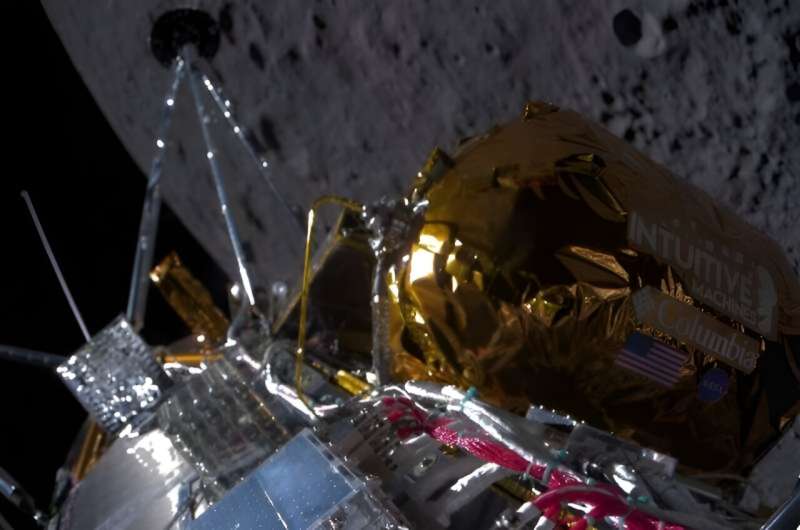Exploring the Neurology of Pair Bonding and Advancements in Robotics

February 24, 2024 report
This article has been reviewed according to Science X's editorial process and policies. Editors have highlighted the following attributes while ensuring the content's credibility:
- fact-checked
- trusted source
- proofread
by Chris Packham , Phys.org
From enraptured voles and space robots on the moon to brain gears and dense objects, it was a heck of a week in science. Let's take a look at some of the most interesting developments over the past seven days.
Prairie voles, native to the U.S. Midwest, are so spectacular at pair bonding that researchers at the University of Texas at Austin studied their brain activity for insights into the formation of long-term monogamous human relationships.
Prairie vole courtship is so fast that if leave to get a beer from the refrigerator, they'll be raising a litter by the time you get back to the couch. Within 30 minutes of meeting, a male and female will have sex repeatedly, many times per hour. Within 24 hours, they establish a lifelong pair bond marked by mutual grooming and emotional support, and both partners ultimately care for their young together.
In their study, the researchers found high activity in 68 brain regions comprising seven brain-wide circuits. This activity correlated with three stages: mating, bonding, and establishing an enduring bond. Because they found so many brain regions not previously associated with bonding, the researchers think the study could identify corresponding human brain regions for future studies of human pair bonding.
Surprisingly, they also found that the active brain regions were virtually identical between males and females, contradicting previous assumptions that the mechanisms involved differed between the sexes.
'For All Mankind,' an Apple TV+ series, posits an alternate history in which the Soviet Union landed on the moon first and the space race accelerated from there to multiple Earth colonies on the moon and Mars. Here on smelly old Earth-616, the space race ended in the 1970s when the Soviets ran out of space money, and NASA decided low-Earth orbit was a good enough exploratory foothold.
But for the first time since 1972, an American craft has landed on the moon. The uncrewed, robotic Odysseus, built by the Houston, Texas-based Intuitive Machines, gave its flight controllers a healthy scare right before final descent when a laser instrument that provides data on altitude and velocity malfunctioned.
After substituting an experimental device built by NASA, the craft landed successfully and began transmitting data. A triumph for the private sector, with an emergency assist from the public sector. You're welcome, Intuitive Machines! Signed, all taxpayers.
Your brain is a lot like a car transmission. It has multiple gears and a lot of modes that only operate within certain gears, and survival is often dependent on the ability to slam the brain into high-intensity fear mode, often without using the clutch.
A brain structure residing in one of the more venerable old evolutionary regions of the brain called the amygdala generates survival responses and regulates the transition to intense fear behaviors in response to perceived threats like a huge Bengal tiger springing out of the underbrush or your boss asking if you can 'jump on Zoom for a quick chat.'
Dysregulation results in psychiatric illnesses and fun symptoms like anxiety. U.S. neuroscientists have now discovered a previously unknown neural pathway associated with encoding the transition to high-intensity fear responses. In an experiment involving in vivo calcium imaging with mice, they found a connection between the prefrontal cortex and the amygdala.
By manipulating this pathway, they observed neurotransmitter release from the prefrontal cortex to neurons in the amygdala that, according to the researchers, 'directly scales the level of fear that the animals are experiencing.'
Right now, at this very moment, untold billions of neutrinos are drifting right through your body as though you were nothing but a diffuse cloud of baryons (this is exactly what you are). Neutrinos are fermions that interact only via the weak nuclear force and gravity.
Their mass is so vanishingly small that physicists once thought it was zero. Anyway, the day before Supernova 1987-A was first detected 37 years ago, astronomers detected neutrinos blasted away from the explosion, indicating that a neutron star had likely formed.
But until this week, they were unsure about whether the neutron star persisted or continued collapsing into a singularity. Astronomers using the James Webb Space Telescope, MIRI, and NIRSpec have now observed the supernova at infrared wavelengths, detecting ions that could only have resulted from the ultraviolet and X-ray emissions of a persistent neutron star.
That's the week in science reporting. Until next week, this diffuse cloud of baryons says, 'Adios, amigos.'
© 2024 Science X Network




